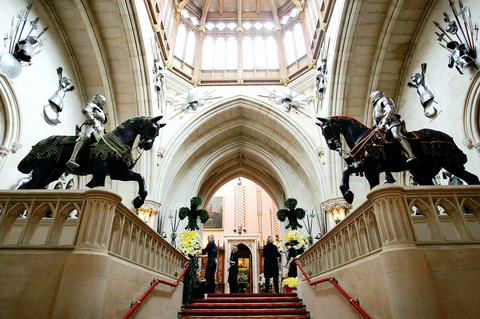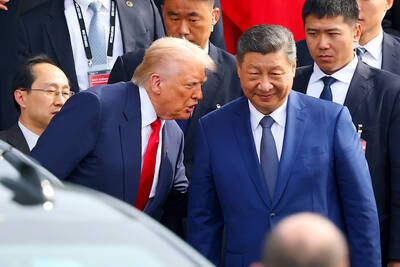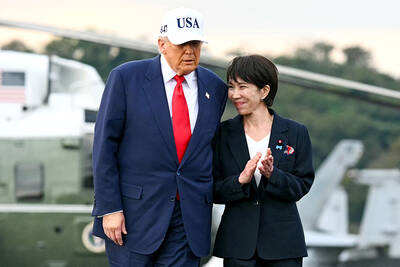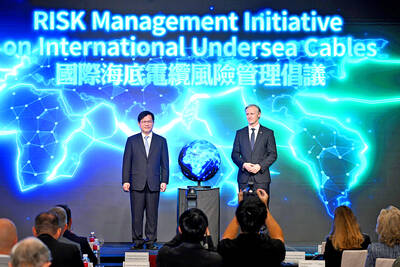Prince Charles and Camilla Parker Bowles married yesterday at the 17th century Guildhall, capping a decades-long romance that survived scandal and turmoil through the prince's first marriage to Princess Diana.
Camilla now takes on Diana's previous status as Princess of Wales, although she plans to defer to public sentiment by avoiding the title and will instead be known as the Duchess of Cornwall.
To the cheers of an estimated 15,000 well-wishers and a few scattered boos, the couple was driven back to Windsor Castle in a vintage Rolls Royce as a jazz band played Congratulations.

PHOTO: AFP
The bride was wearing an oyster silk basketweave coat with a herringbone stitch and a matching chiffon dress. She also wore a matching straw and lace hat with feather details.
Instead of the military uniform he wore at his first wedding, Charles donned formal morning wear, and the simplicity of the wedding at Windsor's brick-and-marble town hall stood in stark contrast to the pomp and grandeur of the first royal nuptials in St. Paul's Cathedral.
Excited cheers greeted Prince William and Prince Harry as the formally attired young men arrived at the Guildhall. William smiled at the crowd, and Harry waved shyly.

PHOTO: REUTERS
Jasmine and Lily of the Valley -- known to symbolize the return of happiness -- lined the hall where the civil ceremony took place.
As the couple arrived, there were some scattered boos and catcalls from onlookers but they were drowned out by overwhelming applause and cheer.
Nearly eight years after Diana's death, some have bridled at accepting Parker Bowles as a future queen, seeing her relationship with Charles as the reason his first marriage fell apart.
The wedding represents a break in tradition for the 50-something divorcees who were getting married in a civil ceremony that Queen Elizabeth II was not attending. The queen was expected at a blessing ceremony scheduled later in the day.
Lining the streets of this handsome old town buffed to a royal luster for the wedding, the crowds waited in chilly sunshine for the nuptials, postponed a day for the pope's funeral.
"It's up to him who he marries," said Barbara Murray, 41, who camped out in this royal hub overnight with her two daughters to stake out a vantage point to see the couple. "Whoever he chose wouldn't be the same as Diana."
"She broke up their marriage," said Yvonne Williams, 67, who raised a banner that read "Long live the Queen, Diana Forever: King Charles, Queen Camilla -- Never."
Security was very tight. In addition to snipers on rooftops, plainclothes officers moved around in the crowd, sniffer dogs and police armed with handguns watched over streets around Windsor Castle.
Thames Valley Police, responsible outside the castle, had 550 officers on duty and Scotland Yard, which is in charge inside the castle had dozens, including sharpshooters.
After the civil ceremony, Archbishop of Canterbury Rowan Williams was to lead a blessing service in St. George's Chapel, and the queen was to give a reception.
When Charles takes the throne, she will legally be the queen, but wishes to be known as Princess Consort -- a bow to opinion polls that show 70 percent of the population opposed to Queen Camilla.
On Friday, Prince Charles joined world leaders and hundreds of thousands of pilgrims at the funeral of Pope John Paul II in Rome. Charles had delayed his wedding by a day to attend the service.
Parker Bowles, meanwhile, met Friday with her couturier, milliner and shoe designer -- adding the finishing touches to her wedding day outfit, which was kept secret.
In keeping with tradition, Parker Bowles spent Friday night at Clarence House, the London residence of the Prince of Wales, while Prince Charles spent the night at his country mansion in Gloucestershire, with his sons William and Harry.
Parker Bowles, wearing a blue jacket, smiled and waved Saturday morning as she set out for Windsor, a riverside town 30km west of London.

UKRAINE, NVIDIA: The US leader said the subject of Russia’s war had come up ‘very strongly,’ while Jenson Huang was hoping that the conversation was good Chinese President Xi Jinping (習近平) and US President Donald Trump had differing takes following their meeting in Busan, South Korea, yesterday. Xi said that the two sides should complete follow-up work as soon as possible to deliver tangible results that would provide “peace of mind” to China, the US and the rest of the world, while Trump hailed the “great success” of the talks. The two discussed trade, including a deal to reduce tariffs slapped on China for its role in the fentanyl trade, as well as cooperation in ending the war in Ukraine, among other issues, but they did not mention

CALL FOR SUPPORT: President William Lai called on lawmakers across party lines to ensure the livelihood of Taiwanese and that national security is protected President William Lai (賴清德) yesterday called for bipartisan support for Taiwan’s investment in self-defense capabilities at the christening and launch of two coast guard vessels at CSBC Corp, Taiwan’s (台灣國際造船) shipyard in Kaohsiung. The Taipei (台北) is the fourth and final ship of the Chiayi-class offshore patrol vessels, and the Siraya (西拉雅) is the Coast Guard Administration’s (CGA) first-ever ocean patrol vessel, the government said. The Taipei is the fourth and final ship of the Chiayi-class offshore patrol vessels with a displacement of about 4,000 tonnes, Lai said. This ship class was ordered as a result of former president Tsai Ing-wen’s (蔡英文) 2018

Japanese Prime Minister Sanae Takaichi yesterday lavished US President Donald Trump with praise and vows of a “golden age” of ties on his visit to Tokyo, before inking a deal with Washington aimed at securing critical minerals. Takaichi — Japan’s first female prime minister — pulled out all the stops for Trump in her opening test on the international stage and even announced that she would nominate him for a Nobel Peace Prize, the White House said. Trump has become increasingly focused on the Nobel since his return to power in January and claims to have ended several conflicts around the world,

GLOBAL PROJECT: Underseas cables ‘are the nervous system of democratic connectivity,’ which is under stress, Member of the European Parliament Rihards Kols said The government yesterday launched an initiative to promote global cooperation on improved security of undersea cables, following reported disruptions of such cables near Taiwan and around the world. The Management Initiative on International Undersea Cables aims to “bring together stakeholders, align standards, promote best practices and turn shared concerns into beneficial cooperation,” Minister of Foreign Affairs Lin Chia-lung (林佳龍) said at a seminar in Taipei. The project would be known as “RISK,” an acronym for risk mitigation, information sharing, systemic reform and knowledge building, he said at the seminar, titled “Taiwan-Europe Subsea Cable Security Cooperation Forum.” Taiwan sits at a vital junction on